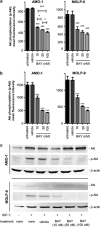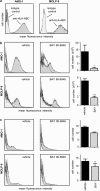A novel selective small-molecule PI3K inhibitor is effective against human multiple myeloma in vitro and in vivo
- PMID: 24013662
- PMCID: PMC3789203
- DOI: 10.1038/bcj.2013.37
A novel selective small-molecule PI3K inhibitor is effective against human multiple myeloma in vitro and in vivo
Abstract
Developing effective therapies against multiple myeloma (MM) is an unresolved challenge. Phosphatidylinositol-3-kinase (PI3K) activation may be associated with tumor progression and drug resistance, and inhibiting PI3K can induce apoptosis in MM cells. Thus, targeting of PI3K is predicted to increase the susceptibility of MM to anticancer therapy. The lead compound of a novel class of PI3K inhibitors, BAY80-6946 (IC50=0.5 nM against PI3K-α), was highly efficacious in four different MM cell lines, where it induced significant antitumoral effects in a dose-dependent manner. The compound inhibited cell cycle progression and increased apoptosis (P<0.001 compared with controls). Moreover, it abrogated the stimulation conferred by insulin-like growth-factor-1, a mechanism relevant for MM progression. These cellular effects were paralleled by decreased Akt phosphorylation, the main downstream target of PI3K. Likewise, profound antitumoral activity was observed ex vivo, as BAY80-6946 significantly inhibited proliferation of freshly isolated myeloma cells from three patients (P<0.001 compared with vehicle). In addition, BAY80-6946 showed convincing in vivo activity against the human AMO-1 and MOLP-8 myeloma cell lines in a preclinical murine xenograft model, where treatment with 6 mg/kg every other day for 2 weeks reduced the cell numbers by 87.0% and 69.3%, respectively (P<0.001 compared with vehicle), without overt toxicity in treated animals.
Figures






Similar articles
-
Mammalian target of rapamycin inhibitors activate the AKT kinase in multiple myeloma cells by up-regulating the insulin-like growth factor receptor/insulin receptor substrate-1/phosphatidylinositol 3-kinase cascade.Mol Cancer Ther. 2005 Oct;4(10):1533-40. doi: 10.1158/1535-7163.MCT-05-0068. Mol Cancer Ther. 2005. PMID: 16227402
-
High throughput chemical library screening identifies a novel p110-δ inhibitor that potentiates the anti-myeloma effect of bortezomib.Oncotarget. 2016 Jun 21;7(25):38523-38538. doi: 10.18632/oncotarget.9568. Oncotarget. 2016. PMID: 27229530 Free PMC article.
-
Copanlisib, a novel phosphoinositide 3-kinase inhibitor, combined with carfilzomib inhibits multiple myeloma cell proliferation.Ann Hematol. 2019 Mar;98(3):723-733. doi: 10.1007/s00277-018-3547-7. Epub 2018 Nov 15. Ann Hematol. 2019. PMID: 30430191
-
The PI3K inhibitor GDC-0941 combines with existing clinical regimens for superior activity in multiple myeloma.Oncogene. 2014 Jan 16;33(3):316-25. doi: 10.1038/onc.2012.594. Epub 2013 Jan 14. Oncogene. 2014. PMID: 23318440
-
Novel therapies targeting the myeloma cell and its bone marrow microenvironment.Semin Oncol. 2001 Dec;28(6):607-12. doi: 10.1016/s0093-7754(01)90033-8. Semin Oncol. 2001. PMID: 11740818 Review.
Cited by
-
Kinase inhibitors as potential agents in the treatment of multiple myeloma.Oncotarget. 2016 Dec 6;7(49):81926-81968. doi: 10.18632/oncotarget.10745. Oncotarget. 2016. PMID: 27655636 Free PMC article. Review.
-
Tissue-specific identification of multi-omics features for pan-cancer drug response prediction.iScience. 2022 Jul 19;25(8):104767. doi: 10.1016/j.isci.2022.104767. eCollection 2022 Aug 19. iScience. 2022. PMID: 35992090 Free PMC article.
-
Novel agents in the treatment of multiple myeloma: a review about the future.J Hematol Oncol. 2016 Jun 30;9(1):52. doi: 10.1186/s13045-016-0282-1. J Hematol Oncol. 2016. PMID: 27363832 Free PMC article. Review.
-
Distinct roles of class I PI3K isoforms in multiple myeloma cell survival and dissemination.Blood Cancer J. 2014 Apr 25;4(4):e204. doi: 10.1038/bcj.2014.24. Blood Cancer J. 2014. PMID: 24769645 Free PMC article. No abstract available.
-
A virtual screen identified C96 as a novel inhibitor of phosphatidylinositol 3-kinase that displays potent preclinical activity against multiple myeloma in vitro and in vivo.Oncotarget. 2014 Jun 15;5(11):3836-48. doi: 10.18632/oncotarget.1657. Oncotarget. 2014. PMID: 25003534 Free PMC article.
References
-
- Raab MS, Podar K, Breitkreutz I, Richardson PG, Anderson KC. Multiple myeloma. Lancet. 2009;374:324–339. - PubMed
-
- Attal M, Harousseau J-L, Facon T, Guilhot F, Doyen C, Fuzibet JG, et al. Single versus double autologous stem-cell transplantation for multiple myeloma. N Engl J Med. 2003;349:2495–2505. - PubMed
-
- Kyle RA, Rajkumar SV. Multiple myeloma. N Engl J Med. 2004;351:1860–1873. - PubMed
-
- Lenhoff S, Hjorth M, Holmberg E, Turesson I, Westin J, Nielsen JL, et al. Impact on survival of high-dose therapy with autologous stem cell support in patients younger than 60 years with newly diagnosed multiple myeloma: a population-based study. Nordic Myeloma Study Group. Blood. 2000;95:7–11. - PubMed
-
- Richardson P, Hideshima T, Anderson KC. An update of novel therapeutic approaches for multiple myeloma. Curr Treat Options Oncol. 2004;5:227–238. - PubMed
LinkOut - more resources
Full Text Sources
Other Literature Sources

